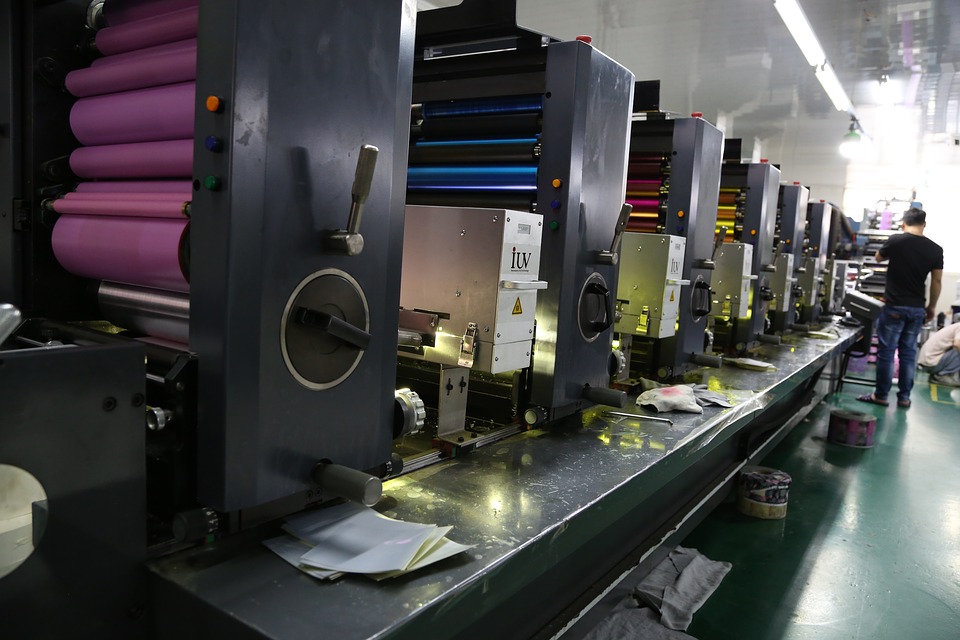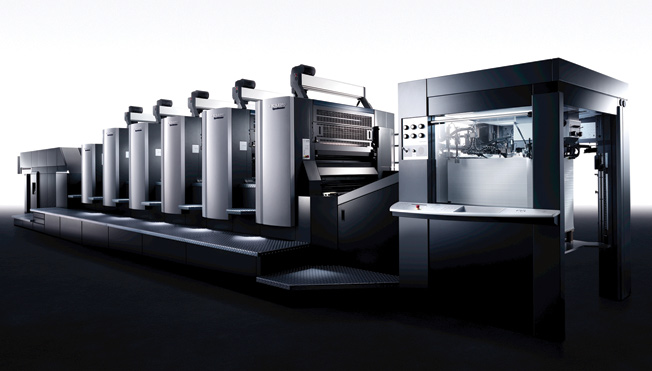Offset printing is the most widely used printing technique in the world. Due to the low price of the print and high quality of printed products it is used in the production of packaging, commercial printing, printing of labels and other printed products.

The history of the offset is linked to lithography or stone printing. In the period between 1796 and 1819, Alois Senefelder succeeded in making a printing form on which the printing elements and free surfaces were in the same plane. The stone surface is protected on a way that free surface is hydrophilic (has a feature to receive water), and the printing surface is hydrophobic (water repellent).
After moistening the stone, the free surfaces are coated with a thin layer of water that reflects the ink, while the printing form takes the ink itself. The technological process is therefore carried out by wetting the surface of the stone, after which the oily ink is applied to the entire printing form. The ink remains only on the printing surface where there is no water – this is the principle of lithography.

Lithography printing is a direct printing technique, which means that the printing form and printing medium are in direct contact during the process of printing. In 1904, American W. Rubel constructed an additional rubber cylinder through which the printing ink was indirectly transmitted to the print media.
Since then, the offset printing technology has changed significantly, even though the physical principle of printing is identical. These days the most commonly used printing form is aluminum plate from 15 to 70 microns thick coated with a photo-sensitive layer. Getting the printing form at the beginning was a completely analogous process. Over time, with digitalization of photographic and preparation processes, was used a film that was digitally illuminated on CTF (computer-to-film) devices. In this way color separations were obtained and were transmitted to the printing plate by the subsequent lighting process.
These days, the printing plate is developed by direct illumination at a CTP (computer-to-plate) devices.

Thus developed printing plate is mounted on the plate cylinder in the printing machine. Within the printing machine there is a complex system of cylinders (plate, blanket, and impression) and rollers (for wetting and inking) which synchronized with the transport transferees the ink on the printing substrate. With the transport of media (paper, cardboard…) on which the motif is printed throughout four basic printing units (CMYK), a color print is obtained. Modern offset printing machines often have more than four units in the series, and along with the basic CMYK inks, additional units for varnishing or units for more colors (like Pantone colors) are often used, which increases the gamut of prints or we can print a specific color according to the customer’s wishes.

The basic configuration of the offset printing machine consists of one printing unit, such machines are called one color, while in larger printing companies we can see machines with eight or ten printing units. With these machines in one pass can be printed on both sides (4/4). Depending on the type of media on which is printed, offset machines are divided into two main groups: sheetfed printing machines (print on individual sheets of paper or cardboard) and web printing machines (print on continuous rolls of paper). Sheetfed printing machines are most often used for commercial printing and printing of packaging, while web printing machines are used for label printing (narrow web roll) or in newspaper printing – offset rotations.

Today, the share of printed materials by offset technology in the world is estimated at 40 to 45%. After World War II, the share of this technology was about 50%, but it was replaced by other technologies, such as flexoprinting. These days, digital printing technology has also negatively affect on the share of offset printing on the printing market.
Sheetfed printing machines are produced in formats from B3 to B1 and larger. Printing speeds is up to 18,000 sheets per hour, while the speed of the web presses are far higher.
Advantages and disadvantages of offset printing
ADVANTAGES
– High quality print
– a simple and fast production of plates
– costs of printing (cheap way of creating high-quality products in large series)
– long lifetime of printing plate

DISADVANTAGES
– a higher fixed cost of preparing the printing press
– the time of preparation of the printing machine in relation to digital technologies
Offset Printing remains the dominant technology on the market
There is no secret that offset printing, as a whole, is a mature branch without market growth. We have all heard and read about how the number of printed offset pages is continually decreasing, causing a strong battle among producers of offset printing machines. But in spite of all, offset technology is still the dominant world printing technology that holds almost half of the world’s consumption of printed applications. According to the analyses of Info Trend’s “2013-2018 Global Production Printing & Copy Marketing Forecast,” the overall digital printing will grow to 500 billion pages printed with digital technologies, but this volume represents a very small share of total printed material worldwide. Of course, digital printing is growing rapidly, but still it is small piece of pie compared to the huge slice covered by offset printing technology.
New generation of offset machines – fast and sophisticated
On the other hand, new technologies implemented in offset printing machines brings easier management and faster plate changing, which significantly reduces the time of preparation of the order.
It provides strong support for frequent switching of the jobs and cost-effective production of small orders. The price of plates have also been reduced and the offset continues to race with digital printing in producing smaller orders.
High-automated offset printing machines, besides high speed and lower cost of production, have up to six times less waste which significantly is affecting the profitability of the entire production. Lack of flexibility that is attributed to “sluggish” offset technology changes with the using of the new UV inks. Materials printed with UV inks directly from the printing press goes to the finishing process without the need for one-day drying in the warehouse and the buyer sometimes can receive his order in just a few hours after the order is made.

Intelligent software solutions have also penetrated into all segments of the production process from the web-2-print ordering interface, control of the entire process of printing and finishing to automated warehouses and delivery of goods to the customer.
New generation offset machines are sophisticated devices connected with service departments in the factory of producers of this machines. Monitoring all vital functions of the machine reduces downtimes caused by failure and contributes to more economical service intervals.
The key is in reinvesting
The owners of printing houses hardly allocate funds for the modernization of its plants. Almost always there is lack of resources to invest in new, more economical offset machines. However, reinvesting is the key to survival in the market. The combination of new, high-speed offset printing machines, quick change of plates and a software controlled production process can effectively oppose to the digital printing process.
Offset printers will have to be transformed
Offset printing houses in the scope we remember them will no longer exist. One part will be transformed into digital print shops that will be at the service of local governments and the local economy and will work closely with large printers on the distribution of their products.
For those offset printers that follow the industry, especially pharmaceutical or food industry, it makes sense to invest in the most modern offset printing machines and automated postpress equipment required for the production of packaging. According to available analyzes and trends, packaging production will have a significant growth in the coming years.
The third segment are specialized commercial offset printers that will deliver large volumes of printed products to small digital printers or end-customers, and will use digital printers such as the retail sector for collecting jobs.

Is there anything that could revive the offset and restore it to the former glory?
Currently all relevant studies support the significant growth of digital technology. Industry expert and analyst Frank Romano has predicted reduction of the volume of offset printing from 49% that was in 2012 to 37% by 2020. Digital inkjet will rise by 9 to 21% in the same time frame. “The numbers do not lie. Volume of offset decreases, while the volume of digital grows. At some point the offset will be between 30 and 40 percent of the total print volume, but still will continue to be the best technology used for large quantity of prints, and perhaps because of its ability to work with spot colors and to print on a large number of different substrates. The offset will still be here, but some offset printers will not. If you look at any sector or ultimate market in the printing industry today, you will notice that the biggest triggers are the demands for short runs, lower minimum quantities, personalization and just-in-time printing. These are things for which offset or other analogue technology are generally not appropriate, “commented in one of his presentations Romano.
According to Mr. Jim Hamilton, an Info Trends analyst, there are no upcoming trends that indicate that the return of the offset printing might come. There are plenty of opportunities for hybrid solutions that use the benefits of offset production together with digital aggregates, enabling personalization. Much is changed with new inkjet technologies that are now fast enough to work with speeds like offset machines do. “The offset will continue to decline in terms of total volume of pages, but it will not disappear. Offset technology is capable of producing large amounts of documents at a low cost and will still be valuable to many printing applications, “says Hamilton.
The new role of the press
If we ask the question What is the future of the offset printing, we should also raise the question What is the future of the printing generally? The upcoming wave of new technologies – such as tablets, social media, smartphones, and more – now becomes a significant carrier of information presented to the user.

Providers of information discover a more efficient way of using new media that they use for well-planned and executed campaigns. Like offset, neither the printing will disappear, but will probably have a secondary role in the cross media world.